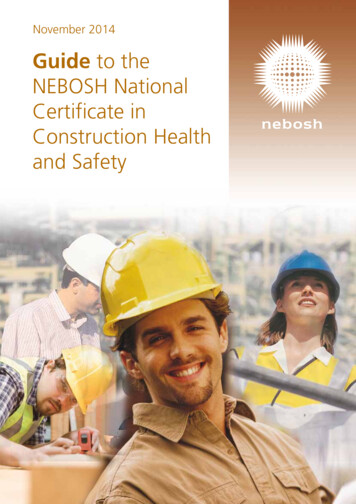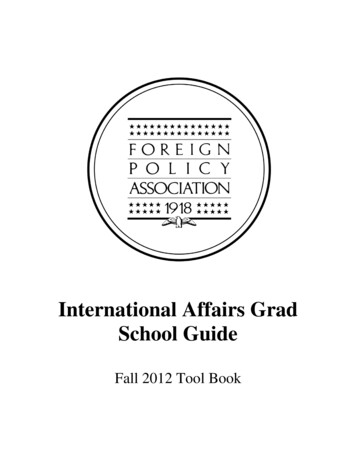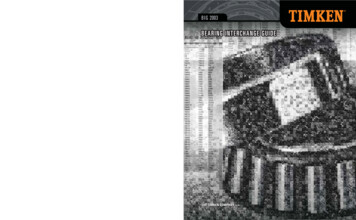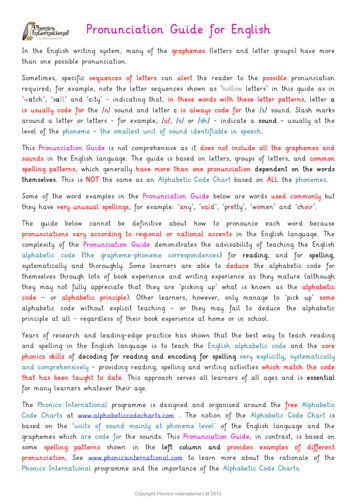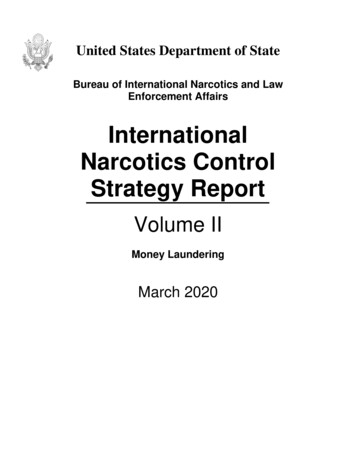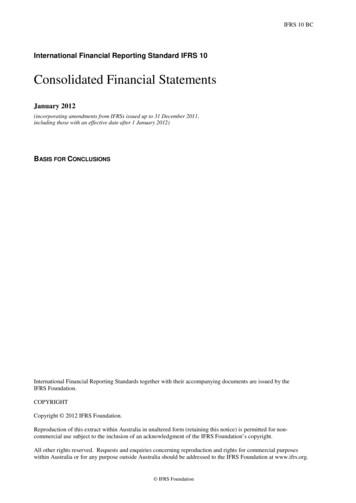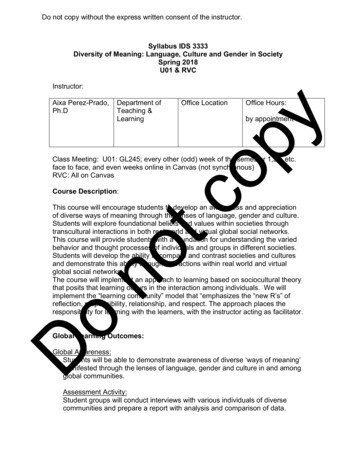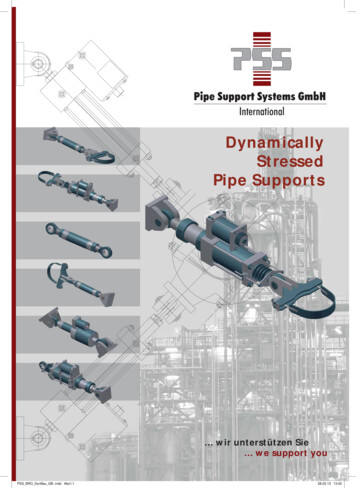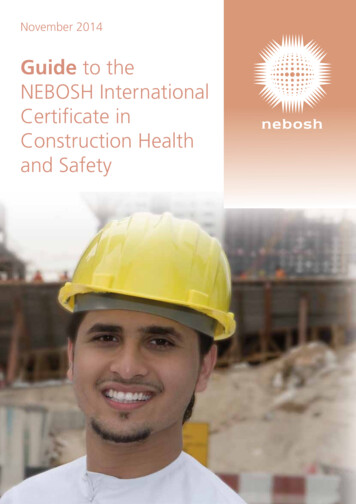
Transcription
November 2014Guide to theNEBOSH InternationalCertificate inConstruction Healthand Safety
Qualification Title: NEBOSH International Certificate in Construction Health andSafetyGuide Version: 3Specification date: November 2014Guide publication date: November 2016The National Examination Board in Occupational Safety and Health (NEBOSH),Dominus Way, Meridian Business Park, Leicester LE19 1QW.Registered Charity Number: 1010444Telephone:Fax:Email:Website: 44 (0) 116 263 4700 44 (0) 116 282 4000info@nebosh.org.ukwww.nebosh.org.uk NEBOSHAll rights reserved. No part of this publication may be reproduced, stored in a retrieval system ortransmitted in any form, or by any means, electronic, electrostatic, mechanical, photocopied orotherwise, without the express permission in writing from NEBOSH. NEBOSH 2016
Guide to the NEBOSH International Certificate inConstruction Health and Safety (November .181.192.1222333444445555666Qualification structure2.12.22.32.42.52.62.72.83.Benefits for employersProfessional membershipQualification level and UK accreditationKey topics coveredCourse tuition and private study time requirementsEntry requirementsMinimum standard of English required for candidatesLanguagesLegislationLegislative updatesNational Occupational StandardsQualification typeQualification progressionProgrammes offered by NEBOSH-accredited course providersExamination datesSpecification dateSyllabus development and reviewFurther information for candidatesFurther information for accredited course providersUnit assessmentUnit exemptionsAchieving the qualificationUnit pass standardUnit certificatesQualification gradeQualification parchmentRe-sitting unit/s78888889Policies3.13.23.33.4Requests for access arrangements/reasonable adjustmentsRequests for special considerationEnquiries about results and appealsMalpractice NEBOSH 201610101011
4.Syllabus - NEBOSH International Certificate in Construction Health and Safety(November 2014 specification)124.1 Unit IGC1: Management of international health and safetyElement 1:Element 2:Element 3:Element 4:Element 5:Foundations in health and safetyHealth and safety management systems - PlanHealth and safety management systems - DoHealth and safety management systems -CheckHealth and safety management systems 4 - ActUnit IGC1 Tutor References1516182325274.2 Unit ICC1: Managing and controlling hazards in international constructionactivitiesElement 1:Element 2:Element 3:Element 4:Element 5:Element 6:Element 7:Element 8:Element 9:Element 10:Element 11:Element 12:Construction managementConstruction site – hazards and risk controlVehicle and plant movement – hazards and risk controlMusculoskeletal – hazards and controlWork equipment – hazards and risk controlElectrical safetyFire safetyChemical and biological health – hazards and risk controlPhysical and psychological health – hazards and risk controlWorking at height – hazards and risk controlExcavation work and confined spaces – hazards and risk controlDemolition and deconstruction – hazards and risk controlUnit ICC1 Tutor References293134363840424447495153564.3 Unit ICC2: International construction health and safety practical application4.2.14.2.24.2.34.2.44.2.54.2.65.Purpose and aimMarkingAssessment locationAssessment requirementsSubmission of completed workFurther information596060606161Sample examination papers5.15.2Unit IGC1: Management of international health and safetyUnit ICC1: Managing and controlling hazards in internationalconstruction activities NEBOSH 20166265
The Guide to the NEBOSH International Certificate in Construction Health andSafety (November 2014 specification)1.IntroductionThe International Certificate in Construction Health and Safety is suitable for supervisors andmanagers within the construction industry outside of the UK and is designed to provide asound breadth of underpinning knowledge that enables them to manage construction riskseffectively.The NEBOSH International Construction Certificate is also suitable for those embarking on acareer in health and safety, providing a valuable foundation for further professional study(such as the NEBOSH International Diploma).The International Construction Certificate is modelled on the NEBOSH National ConstructionCertificate. The key difference between the two qualifications is in the applicability of legalrequirements. Rather than be guided by a specifically UK framework, the InternationalConstruction Certificate takes a risk management approach based on best practice andinternational standards, such as International Labour Organisation (ILO) codes of practice,with special reference to the model proposed in the ILO's "Guidelines on OccupationalSafety and Health Management Systems" (ILO-OSH 2001). Local laws and cultural factorsform part of the study programme where relevant and appropriate.1.1Benefits for employersDespite the increasing global recognition of the importance of health and safety at work,accidents and work-related ill-health continue to affect all types of workplaces andoccupations. The ILO estimates that approximately 2 million workers per year die ofoccupational injuries and illnesses, equivalent to over 5,000 workers dying worldwide everyday. At least 355,000 of these deaths are due to accidents at work. There are an estimated500 – 2000 non-fatal injuries for every fatal injury (including 160 million cases of workrelated disease), many of which result in lost earnings, lost jobs and permanent disabilityand poverty.The business impact of workplace accidents and ill-health is also compelling – in addition tothe direct costs of sick pay and absence, employers can find themselves dealing withcriminal prosecution, claims for compensation, adverse publicity and harm to both businessreputation and profitability. In the UK alone the estimated annual cost of occupational injuryand illness is 5 billion to employers and 16 billion to the British economy. The annualworldwide cost of occupational injury and illness is estimated by the ILO to be twenty timesgreater than the total amount of official development assistance provided to developingcountries (approximately 50 billion).The vast majority of construction injuries, accidents and ill-health are avoidable by goodhealth and safety management. By saving money, improving productivity and raisingworkforce morale, effective health and safety management should be recognised as anessential element of a successful management strategy.Many larger organisations choose the NEBOSH qualifications as a key part of theirsupervisors’ or management development programme. By ensuring that line managershave a sound understanding of the principles of risk management they build an effectivesafety culture in the organisation. NEBOSH 20161
The Guide to the NEBOSH International Certificate in Construction Health andSafety (November 2014 specification)This course can be delivered within an organisation, or employees can attend accreditedtraining courses run by our network of accredited course providers. NEBOSH accreditedcourse providers offer a variety of flexible course formats, so training can be arrangedaccording to employer needs.1.2Professional membershipHolders of NEBOSH National Certificate in Construction Health and Safety are entitled toAssociate Membership (AIOSH) of the Institution of Occupational Safety and Health (IOSH).The qualification also meets the academic requirements for Technical membership (TechIOSH) of the Institute of Occupational Safety and Health (IOSH – www.iosh.co.uk).The NEBOSH National Certificate in Construction Health and Safety meets the headlineentrance criteria requirements for Construction Safety Associate membership (AaPS) of theAssociation for Project Safety (APS - www.aps.org.uk).Holders of the NEBOSH National or International Diploma in Occupational Health and Safetyand the NEBOSH National or International Certificate in Construction Health and Safetymeet the headline entrance criteria requirements for Registered Construction SafetyPractitioner (RMaPS) membership of the Association for Project Safety (APS).Holders of this qualification are also entitled to Associate membership (AIIRSM) of theInternational Institute of Risk and Safety Management (IIRSM – www.iirsm.org).1.3Qualification level and UK accreditationThe NEBOSH International Certificate in Construction Health and Safety is accredited andcredit rated by the Scottish Qualifications Authority Accreditation (SQA Accreditation –www.sqa.org.uk) for delivery across the UK. It is rated within the Scottish Credit andQualifications Framework (SCQF - www.scqf.org.uk) at SCQF Level 6 with 17 SCQF creditpoints.For users in England, Wales and Northern Ireland, this is comparable to a VocationallyRelated Qualification (VRQ) at Level 3 within the National Qualifications Framework (NQF)and Qualifications and Credit Framework (QCF), or A-Level standard.For further information please refer to the “Qualifications can cross boundaries” comparisonchart issued by the UK regulators, available from the SQA website (www.sqa.org.uk).1.4Key topics covered International standards for health and safety at work Implementation of health and safety management systems Identification of workplace hazards within the construction industry Methods of risk control within the construction industry Practical application of knowledge and understanding NEBOSH 20162
The Guide to the NEBOSH International Certificate in Construction Health andSafety (November 2014 specification)1.5Course tuition and private study time requirementsUnit IGC1: 36 hours tuition and 23 hours private studyUnit ICC1: 68 hours tuition and 29 hours private studyUnit ICC2: 2 hours tuition and 6 hours private studyTotal: 59 hoursTotal: 97 hoursTotal: 8 hoursA programme of study therefore needs to be based around a minimum of 106 taught hoursand approximately 58 hours of private study for an overall total of 164 hours.A full-time block release course would be expected to last for a minimum of three weeks(fifteen working days) and a part-time day release course would be spread over at leastfifteen weeks. For candidates studying by open or distance learning, the tuition hours shouldbe added to the recommended private study hours to give the minimum number of hoursthat this mode of study will require.Quoted hours do not include assessment time, ie, sitting written examinations or thepractical application unit (see 1.4).1.6Entry requirementsThere are no specific barriers, in terms of academic qualifications, skills or experience toentry to the NEBOSH International Construction Certificate programme. However, it shouldbe noted that currently the assessments are offered, and must be answered, in English only.The qualification includes a requirement to write a short report based on the candidate’s ownworkplace, which must also be in English. Candidates should discuss this with theaccredited course provider before undertaking the qualification.1.7Minimum standard of English required for candidatesThe standard of English required by candidates studying for the NEBOSH InternationalConstruction Certificate must be such that they can both understand and articulate theconcepts contained in the syllabus. It is important to stress that the onus is on accreditedcourse providers to determine their candidates’ standards of proficiency in English.NEBOSH recommends to accredited course providers that candidates undertaking thisqualification should reach a minimum standard of English equivalent to an InternationalEnglish Language Testing System score of 6.0 or higher in IELTS tests in order to beaccepted onto an International Construction Certificate programme.For further information please see the latest version of the IELTS Handbook or consult theIELTS website: http://www.ielts.org/institutions/test format and results.aspx.Candidates wishing to assess their own language expertise may consult the IELTS websitefor information on taking the test: http://www.ielts.org/faqs.aspx. NEBOSH 20163
The Guide to the NEBOSH International Certificate in Construction Health andSafety (November 2014 specification)1.8LanguagesUnit examinations are available for 'on demand' examinations in other languages; pleaserefer to your course provider and the NEBOSH website for further details.Examinations in languages other than English cannot be taken in the UK.1.9LegislationThe syllabus refers to international conventions and recommendations. Where thisqualification is delivered overseas, accredited course providers may refer to examples oflocal legislation as part of the course programme but examination questions will not refer tospecific legislation, but will refer to international conventions, recommendations and goodpractice as indicated in the syllabus.1.10 Legislative updatesRelevant new international conventions and recommendations will become examinable indetail six months after their date of introduction. However, candidates will be expected to beessentially up-to-date at the time of the examination and, whilst a detailed knowledge will notbe expected, reference to new or impending international conventions andrecommendations, where relevant to an examination question, will be given credit.Please note, NEBOSH will not ask questions related to international conventions andrecommendations that have been repealed, revoked or otherwise superseded.NB: Accredited course providers are expected to ensure their course notes remain currentwith regard to new international conventions and recommendations.1.11 National Occupational StandardsThe syllabus is mapped to the relevant National Occupational Standards (NOS): NOS for Health and Safety (Standalone units) published by Proskills Proskills StandardsSetting Organisation (www.proskills.co.uk) NOS to Manage health, safety, welfare and environmental factors published byConstructionskills SSC (w
The International Certificate in Construction Health and Safety is suitable for supervisors and managers within the construction industry outside of the UK and is designed to provide a sound breadth of underpinning knowledge that enables them to manage construction risks effectively. The NEBOSH International Construction Certificate is also suitable for those embarking on a
